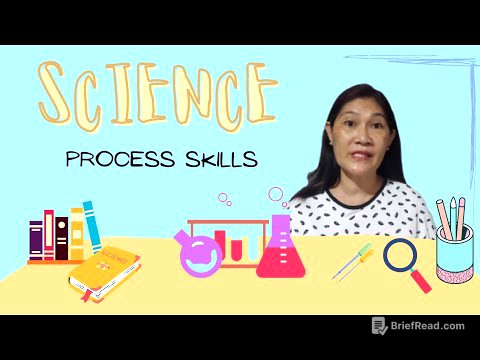TLDR;
This video provides a comprehensive guide to building a successful online marketing strategy. It breaks down the process into three key strategies: business, customer, and marketing. The video emphasizes the importance of shared value, where the goals of the customer and business align. It covers essential online marketing terminology, website optimization, and various marketing channels, including SEO, social media, video, email, and content marketing. The video also delves into data analytics, conversion funnels, and attribution models, providing insights into how to measure and optimize marketing efforts. Finally, it highlights the growing importance of mobile marketing and how to adapt your strategy for a mobile-first world.
- Understand your business, customer, and marketing goals.
- Create a shared value experience for your customers.
- Leverage various online marketing channels effectively.
- Track and analyze data to optimize your strategy.
- Adapt your marketing for a mobile-first world.
Introduction [0:00]
This introductory chapter sets the stage for the video, emphasizing the importance of a well-defined online marketing strategy. It highlights the challenges of online marketing's broad scope and the need for a focused approach. The video introduces the three key strategies: business, customer, and marketing, which will be explored in detail throughout the video.
Online Marketing [0:05]
This chapter emphasizes the importance of building a strong online presence and developing a dedicated strategy to achieve a positive return on investment. It stresses the need to understand the goals of your business, your target audience, and how they use digital technology. The chapter also introduces the concept of shared value, where the goals of the customer and business overlap, and how this should be the foundation of your marketing strategy.
Business Strategy [1:55]
This chapter focuses on defining your business strategy, including your mission statement, objectives, value proposition, and elevator pitch. It also highlights the importance of assessing your business's digital readiness, ensuring you have the right structure, processes, and resources to support your online marketing efforts. The chapter emphasizes the need for a clear understanding of your business to create a successful strategy.
Customer Strategy [4:11]
This chapter delves into understanding your target audience and how to reach them effectively. It emphasizes the importance of identifying the right audience, understanding their motivations, and determining the best marketing channels to connect with them. The chapter also introduces the concept of customer segments and how to define goals, shared value, key performance indicators (KPIs), and targets for each segment.
Marketing Strategy [6:56]
This chapter focuses on developing your marketing strategy, building upon the understanding of your business and customer. It emphasizes the need for tailored plans for each audience segment and explores the different marketing media available: paid, earned, and owned. The chapter encourages a flexible approach, constantly refining your strategy based on data and insights.
Terms / Definitions [8:48]
This chapter provides definitions and explanations for key online marketing terminology, including call to action, bounce rate, click-through rate, abandonment, ad impression, frequency, conversion rate, tracking pixel, cost per acquisition (CPA), and lifetime value (LTV). It also discusses banner advertisements, display ads, and landing pages.
Website [17:21]
This chapter emphasizes the importance of a well-designed and functional website as a crucial part of your online marketing strategy. It highlights the need for a mobile-friendly website, proper loading across browsers, and content that answers user questions. The chapter also stresses the importance of brand consistency and keeping your website up-to-date.
Domain Name [21:52]
This chapter focuses on the importance of choosing the right domain name for your business. It emphasizes the need for a domain name that is relevant, memorable, and usable. The chapter provides tips on selecting the right suffix, avoiding hyphens and special characters, and securing multiple variations of your domain name.
Designer / Developer [24:17]
This chapter provides guidance on finding the right graphic designer and web developer for your website project. It emphasizes the importance of reviewing their portfolio, checking online reviews, and getting recommendations from other businesses. The chapter also highlights the importance of understanding their process, experience with responsive design, and pricing.
Conversion [29:21]
This chapter focuses on website conversion, the process of encouraging visitors to take a desired action, such as making a purchase or signing up for a newsletter. It emphasizes the importance of landing pages, which are specifically designed to drive conversions. The chapter explores different types of landing pages, including teaser pages, squeeze pages, infomercial pages, and viral pages.
Web Copy [34:03]
This chapter focuses on writing engaging web copy that resonates with your target audience. It emphasizes the importance of concise and clear writing, using clever headings, and prioritizing the most important information. The chapter also discusses the benefits of hiring a professional copywriter and how to find the right one for your needs.
Design [36:58]
This chapter explores the concept of responsive web design, which allows your website to adapt to different screen sizes and devices. It highlights the benefits of responsive design, including improved user experience and flexibility for future growth. The chapter also discusses the importance of considering usability and making necessary adjustments to accommodate a responsive experience.
Data [38:45]
This chapter emphasizes the importance of data in online marketing, highlighting how it can be used to improve your website, identify opportunities, and optimize your campaigns. It discusses the use of cookies and pixels to track user behavior and how this data can be leveraged for better targeting and personalization.
Analytics [42:11]
This chapter delves into the world of data analytics, explaining how to capture and interpret data from your website, paid advertising campaigns, and earned media. It discusses the use of tools like Google Analytics and how to track conversions across different platforms. The chapter also emphasizes the importance of setting clear goals and objectives to measure your progress.
Funnels [45:24]
This chapter introduces conversion funnels, which visualize the sales process and help identify potential bottlenecks. It explains how to use funnels to track user behavior, identify areas for improvement, and optimize your website for conversions. The chapter also discusses how to use Google Analytics to create and track funnels.
Key Performance Indicators (KPIs) [47:38]
This chapter focuses on key performance indicators (KPIs), which are specific metrics that help you measure the success of your online marketing efforts. It emphasizes the importance of aligning KPIs with your business goals, making them measurable and easy to understand. The chapter provides examples of KPIs for online sales, broader marketing objectives, and landing pages.
Attribution Models [50:02]
This chapter explores attribution models, which help you understand how to attribute sales to different marketing channels. It discusses the limitations of last click attribution and introduces alternative models, such as view-through conversions. The chapter also explains how to adjust attribution models based on your specific business needs and how to use multi-channel funnels to identify the most valuable channels.
Search Engine Optimization (SEO) [53:37]
This chapter focuses on search engine optimization (SEO), the process of improving your website's visibility in search engine results. It explains how search engines work, including crawling, indexing, and ranking. The chapter also discusses key SEO factors, such as crawlability, keyword optimization, title tags, meta descriptions, heading tags, image optimization, and sitemaps.
SEO [55:44]
This chapter provides practical tips for improving your website's SEO, emphasizing the importance of making your site accessible to crawlers, optimizing your content for keywords, and using heading tags effectively. The chapter also recommends using tools like Google Webmaster Tools and Screaming Frog SEO Spider to analyze your website's SEO health.
Content [59:17]
This chapter emphasizes the importance of creating high-quality content that is relevant to your target audience. It discusses the role of content in SEO and how to optimize your content for keywords naturally. The chapter also highlights the importance of creating content that adds value to your users and establishes your business as an authority in your industry.
Social Media Marketing [1:00:54]
This chapter explores the world of social media marketing, highlighting the importance of a well-defined strategy, creativity, and a consistent presence. It discusses the different social media platforms, including Facebook, Twitter, LinkedIn, and Pinterest, and their unique characteristics and best practices. The chapter also emphasizes the importance of allocating time and resources for social media marketing.
Social Media Networks [1:03:50]
This chapter provides a detailed overview of the four major social media networks: Facebook, Twitter, LinkedIn, and Pinterest. It discusses their demographics, strengths, weaknesses, and best practices for each platform. The chapter encourages businesses to analyze their competition and understand how they are using social media to reach their target audience.
Video Marketing [1:07:41]
This chapter explores the potential of video marketing, highlighting the importance of YouTube as a powerful platform for driving brand awareness and traffic. It discusses the benefits of video marketing, including showcasing your products, telling your brand story, and providing customer support. The chapter also provides examples of successful viral video campaigns and emphasizes the importance of creating high-quality, engaging content.
Compelling Content [1:09:56]
This chapter focuses on creating compelling video content that resonates with your target audience. It emphasizes the importance of captivating viewers within the first few seconds, speaking directly to their needs, and avoiding sales pitches. The chapter also provides tips on video production, including using high-quality cameras, good lighting, and a stable tripod.
Email Marketing [1:12:06]
This chapter explores the power of email marketing, highlighting its importance in today's digital landscape. It discusses the shift from mass email blasts to targeted campaigns that provide value to subscribers. The chapter emphasizes the importance of building your own email list, segmenting your audience, and using drip campaigns to nurture leads and drive conversions.
Email Marketing Plan [1:15:31]
This chapter focuses on developing a strategic email marketing plan, emphasizing the importance of understanding your target audience and their needs. It discusses different methods for acquiring email subscribers, setting clear goals, and creating compelling content that motivates action. The chapter also highlights the importance of considering design, mobile optimization, and timing for your email campaigns.
Content Marketing [1:18:27]
This chapter explores the concept of content marketing, which involves creating valuable content that attracts and engages your target audience. It discusses the benefits of content marketing, including answering user questions, establishing authority, and adding value to the customer journey. The chapter also highlights the importance of content marketing for SEO and how it can be integrated across different channels.
Content Planning [1:20:35]
This chapter focuses on creating a content marketing plan, emphasizing the importance of identifying your target audience, defining your goals, and determining how you will measure success. It discusses the importance of creating a comprehensive content strategy that includes different types of content and encourages a consistent publishing schedule.
Mobile Marketing [1:23:02]
This chapter highlights the growing importance of mobile marketing, emphasizing the increasing use of mobile devices and the need for a mobile-first strategy. It discusses various mobile marketing tactics, including text messaging, QR codes, mobile apps, and location-based services. The chapter encourages businesses to adapt their existing marketing efforts for mobile and prioritize mobile marketing in their overall digital strategy.









